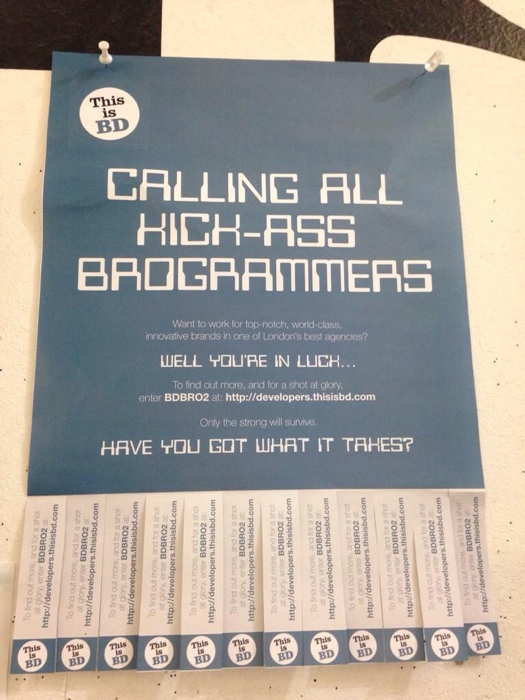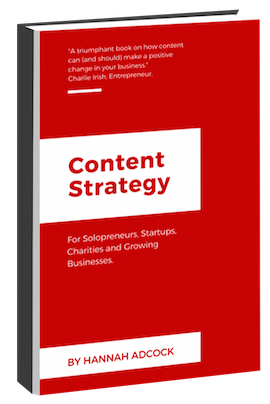Your team is your company’s greatest asset, so it makes sense to recruit people who will love your company, stick around and do some fantastic work. So, how do you recruit these great people? Usually, through some kind of content. You might write a job advert, a blog post, send out some tweets, perhaps send a message down a newsletter. Fab! But not so fab if this content puts off great candidates while attracting poor ones. In this post I’ll look at how you can use some content techniques to write job adverts that work for your company.
1. Know what you want to communicate about your company
Work out what key messages about your company you want to communicate to candidates. Are you fun, friendly and relaxed? Reliable, helpful and considerate? Fast moving, technological and social?
Be truthful rather than aspirational – and be honest. If you have a 95% male team that eats pizza on Friday and considers weekly football tournaments a perk, then you are not ‘diverse’ or ‘approachable’. Of course, you might want to be more diverse, but just saying you are to try and lure in someone under false pretences is not a productive way forward.
When I was writing a job description recently for independent ecommerce platform SendOwl I made a list of what I thought defined them: they are friendly, flexible, and mature.
With this is mind, I led with this elevator pitch:
“This is a great opportunity for someone who wants to do what they love (Rails) without being distracted by commuting, long hours and office politics.
We mainly work remotely, we get the job done but largely work when we want to, and we won’t get snarky if your kid is sick or you need a day off to argue with estate agents or builders (it happens to the best of us).
This job won’t suit you if you mainly care about money, VC networking and free pizza (best of luck to you; it’s just not what we’re about).”
The friendly bit is communicated by the informal style. The flexible bit is shown by examples of when they are flexible, and also by the relaxed syntax. The mature angle is covered by the mention of children (very rare in tech job descriptions) and also by the negative comment about free pizza (which tends to appeal to a younger crowd who will swap free food for long work hours).
2. Show don’t tell
This is a useful maxim no matter what content you’re writing. It basically means that instead of writing ‘The boy was scared’ you instead show he’s scared: ‘His teeth were chattering; his face paled as he clung onto the chair, as if to defend himself from some unknown force’ (Stephen King, eat your heart out).

Showing is generally more effective, engaging and believable than simply telling. So, if you want to communicate you are friendly, don’t just say ‘We’re friendly, we promise!’. Instead, show you’re friendly by writing an approachable job advert. Avoid jargon. Use flowing or shorter sentences rather than complex ones reminiscent of EU reports on tax management. Select short paragraphs rather than long, stodgy paragraphs that are hard to read. Use examples to prove your points.
When I was writing the SendOwl advert I mainly used 1-2 sentence paragraphs plus bullet points, and I backed up claims. So when I said we offered a sensible work-life balance (that ‘sensible’ resonating with mature candidates again), I then immediately specified: you’ll be asked to work 7.5 hours a day and you’ll get 5 weeks holiday.
3. Choose your words carefully
Although it’s a bit dated now, plenty of tech world job descriptions went through a phase where everyone needed to be a ‘coding ninja,’ ‘rockstar’ ‘or customer support hero’.

Personally, this type of language makes me wince, but then I’m English.
More seriously, this type of language will appeal to certain people and not to others. People with a decent sized ego are more likely to react to this kind of language: ‘Of course I’m a rockstar. Yeah!’.
Or this type of language could appeal more to young people up for the kind of culture this language implies (at a guess, pizza, beer and ping pong).
If you want to attract brilliant people with slightly less confidence, older people or people who didn’t necessarily like cartoons as a kid, then you might want to use different language. However, if you want to attract (over) confident whizz kids you may be on the right track.
Here is a perfect example of an advert that will only attract a certain kind of person (the kind you probably don’t want working for your company):

I’m not sure how ‘top notch’ and ‘world class’ an agency is that can come up with such an unashamedly sexist job advert, but there you are.
Even if you don’t use such obviously divisive language as ‘brogrammer’ be sparing in your use of such terms as ‘dominant’, ‘competitive,’ ‘stress-resilient’ and ‘superior’. Taken together, your advert may in fact be shouting WORK HERE AND AGRESSION WILL BE AN INTEGRAL PART OF YOUR LIFE.
Even a term like ‘hacker’ may not resonate with candidates in the way you expect, particularly if it means to you: ‘I’m a cool anti-establishment kind of person’. This is the story of how Buffer attracted a broader range of candidates when they changed some job descriptions from ‘hacker’ to ‘developer’.
4. Don’t forget to use gender neutral pronouns
Unless you want to exclude at least 50% of possible candidates, don’t use ‘he’ in your job advert and wonder why no women applied. Here are a number of companies that made that mistake.

Maybe women shouldn’t be so quick to take offence though, when it was just a silly mistake? Hum. I’ve been inadvertently referred to as a man many times in my career (I’m looking at you RBS and Strava) and it always makes me feel like I’m an outsider, who shouldn’t really be doing something.
Would I apply for a job with a company that made me feel like this? Nope.
Of course, if you don’t want any women to apply then using ‘he’ in your advert is a terrific way of putting them off so you can continue your ‘bromance’ paradise for ever (or until you go out of business).
5. Think carefully about where you’re posting or advertising your advert
If you want to attract a mature developer who wants a good work-life balance then putting up an advert at Google Campus or a tech incubator is probably not going to work.
Equally, posting a tech ad to sites or mailing lists with an almost exclusively male/white/Western readership is probably also not going to reach other types of candidates.
Be careful if you catch yourself thinking ‘if this candidate was good they would be on this site or mailing list’. This just means you secretly want to recruit someone ‘like you’. This might be true, but if so, I worry for the health of your business.
Ideally you want people who share your company values, but who otherwise have a broad range of views on life, the universe and everything.
Don’t forget that even 140 characters is enough to attract or repel potential candidates. When I was advertising the SendOwl post on social media I led with ‘Friendly and flexible Rails job’ rather than simply saying: ‘We’re looking to hire a senior/mid-level Rails dev’.
The latter isn’t bad, but by prioritising a candidate’s experience you are communicating that this is what really matters to you. This initial message might not resonate with highly skilled candidates who get imposter’s syndrome, or who want to work for a company that doesn’t feel so ‘graded’ and corporate. First impressions matter.

6. Challenge your assumptions
There’s no point attracting a wide range of great candidates if you don’t treat their applications fairly. In an ideal world we’d all have an amazing ability to neutralise our assumptions, cultural alignment and life experiences so we can treat everyone the same. However, this isn’t an ideal world and we don’t. It’s nothing really to be ashamed of (it happens to all of us), but it is something that you should spend some time thinking about. For example:
“…Research from Yale that had scientists presented with application materials from a student applying for a lab manager position and who intended to go on to graduate school. Half the scientists were given the application with a male name attached, and half were given the exact same application with a female name attached. Results found that the “female” applicants were rated significantly lower than the ‘males’ in competence, hireability, and whether the scientist would be willing to mentor the student.” - Scientific American.

Don’t be that man or woman who turns down a great candidate because of your internal and often unconscious bias. You’ll miss out on some great people.
Conclusion
Words matter so spend time crafting a job advert that appeals to the kind of candidates you want. Make sure you know what you want to communicate about your company, so candidates know how your company is different, and why they might be a great fit. Remember that it’s not just what you say in a job advert that matters but how you say it. Stilted language, cliches and long paragraphs will quickly contradict any promises you make about working in a fast-paced and creative environment. Most of all, be prepared to spent time not only writing your perfect job advert but also promoting it, and in fairly considering potential candidates who take the time to apply.
Content Strategy for Solopreneurs, Startups, Charities and Growing Businesses
This book will help you tackle 12 common business challenges including making sure you're reaching everyone who could be a customer, persuading people to buy from you and not a competitor, and how you can get your team to produce useful usable content. Read more about the ebook.
You'll learn
- How thinking strategically about your content will drive growth
- Practical tips on creating content strategy deliverables that will save you time and money
- How to create a content strategy for your company in 4 weeks
